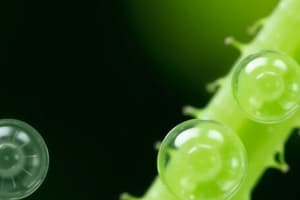Podcast
Questions and Answers
How does cell division in plants differ from that in animals?
How does cell division in plants differ from that in animals?
- Cell division in animals is continuous throughout life.
- Cell division in plants occurs only at certain ages.
- Cell division in plants occurs continuously throughout their life. (correct)
- Cell division is limited to reproductive tissues in both.
Which statement about growth in living organisms is accurate?
Which statement about growth in living organisms is accurate?
- Growth solely refers to increase in body mass.
- A dead organism can still grow if conditions allow.
- Growth in living organisms is only from external sources.
- Growth can occur in non-living objects as well. (correct)
What is true about reproduction in multicellular organisms?
What is true about reproduction in multicellular organisms?
- Reproduction produces progeny similar to the parents. (correct)
- Reproduction implies an increase in body mass only.
- Asexual reproduction is not considered a form of reproduction.
- Reproduction is only observed in higher organisms.
Which of the following describes a characteristic of metabolism?
Which of the following describes a characteristic of metabolism?
Which of these statements is incorrect regarding growth?
Which of these statements is incorrect regarding growth?
What concept does reproduction NOT necessarily encompass?
What concept does reproduction NOT necessarily encompass?
Which of the following scenarios exemplifies a form of asexual reproduction?
Which of the following scenarios exemplifies a form of asexual reproduction?
Why is growth not considered a defining property of living organisms?
Why is growth not considered a defining property of living organisms?
What is considered the defining feature of all living organisms?
What is considered the defining feature of all living organisms?
Which statement best explains the concept of emergent properties?
Which statement best explains the concept of emergent properties?
Which of these can be classified as a response to environmental stimuli?
Which of these can be classified as a response to environmental stimuli?
Why is defining the living state considered challenging?
Why is defining the living state considered challenging?
What unifying aspect connects all living organisms, both past and present?
What unifying aspect connects all living organisms, both past and present?
Flashcards are hidden until you start studying
Study Notes
Growth
- Continuous cell division occurs in plants, allowing for lifelong growth.
- In animals, growth occurs until a certain age, after which cellular division mainly replaces lost cells.
- Cell division can be observed in vitro by counting cell numbers.
- In higher animals and plants, growth does not coincide with reproduction; therefore, they are mutually exclusive.
- Growth is defined as an increase in body mass, which may also apply to non-living objects like mountains and boulders through surface material accumulation.
- Living organisms experience growth from within, highlighting that growth alone cannot define life, as dead organisms do not grow.
- Conditions and contexts of growth must be considered to understand it as a characteristic of living systems.
Reproduction
- Reproduction is essential for living organisms, producing progeny that resemble their parents.
- Primarily refers to sexual reproduction, though asexual reproduction is also prevalent.
- Fungi thrive through asexual reproduction by producing millions of spores.
- Budding is observed in simpler organisms such as yeast and hydra.
- Planaria can regenerate lost body parts, demonstrating true regeneration.
- Fragmentation in organisms like filamentous algae and moss protonema facilitates asexual reproduction.
- In unicellular organisms (e.g., bacteria, Amoeba), reproduction equates to cell growth through division, aligning with the definition of growth.
- The distinction between growth and reproduction in single-celled organisms can be ambiguous.
- Certain organisms, such as mules and infertile humans, do not reproduce, indicating that reproduction alone cannot universally define life.
- Non-living objects do not possess the capability of reproduction.
Metabolism
- All living organisms are composed of chemicals that undergo metabolic reactions.
- Metabolism involves thousands of simultaneous chemical reactions essential for sustaining life.
Metabolism
- Metabolism encompasses all chemical reactions within living organisms, fundamental to plants, animals, fungi, and microbes.
- Non-living entities do not exhibit metabolic activity.
Cellular Organization
- Cellular organization is the essential defining characteristic of all living organisms.
Response to Stimuli
- Organisms demonstrate the ability to respond to environmental stimuli, which can be physical, chemical, or biological.
- This response is considered one of the most complex features of life.
Consciousness
- Consciousness is regarded as the defining property of living beings.
- Humans uniquely possess self-awareness among all organisms.
Defining the Living State
- Defining "living" poses challenges, particularly with individuals in comatose states or those supported by machines.
- A dilemma exists regarding the classification of brain-dead individuals as living or non-living.
Levels of Organization
- Higher classes will explore the hierarchy of biological organization, emphasizing that emergent properties arise from interactions at each level.
- The characteristics of tissues and organelles result from the interactions among their constituent cells and molecular components, respectively.
Biology
- Biology narrates the story of life on Earth, connecting all living organisms—past, present, and future—through shared genetic material.
Studying That Suits You
Use AI to generate personalized quizzes and flashcards to suit your learning preferences.




